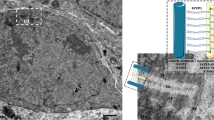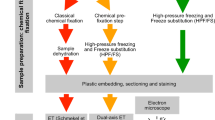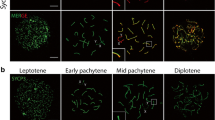Abstract
Electron microscopy of surface-spread spermatocytes from mice heterozygous for a tandem duplication shows the heteromorphic synaptonemal complex (SC) to comprise two lateral elements of unequal length, the longer of which is buckled out in a characteristic loop, representing the unsynapsed portion of the duplication. The loop is a regular feature of late zygotene-early pachytene nuclei; it is longest at these early stages, but, through equalization of the two axes as a consequence of synaptic adjustment, it is replaced by a normal appearing SC at late pachytene. Because equalization, as indicated by a decrease in the percent difference between axes, may begin shortly after completion of synapsis, estimates of duplication segment length are restricted to a sample selected for least adjustment. — Although the mean position of the loop is constant at various pachytene substages, individual positions vary widely from cell to cell, consistent with the behavior expected of a duplication, but not of a deletion or an inversion. The length of the segment that is duplicated is estimated to be 22% of the normal chromosome, the midpoint of the segment is mapped at 0.61 of the chromosome distal to the kinetochore, and the ends of the segment are mapped at 0.50 to 0.72. Measurements of G-banded mitotic chromosomes give comparable values: duplication length, 24%; midpoint, 0.60, and segment ends, 0.48 and 0.71. This agreement constitutes further validation of the SC/spreading method for detecting and analyzing chromosomal rearrangements at pachytene and substantiates the fidelity with which the axes and SCs represent the behavior of chromosomes in synapsis.
Similar content being viewed by others
References
Bernstine, E.G., Russell, L.B., Cain, C.S.: Effect of gene dosage on the expression of mitochondrial malic enzyme activity in the mouse. Nature (Lond.) 271, 748–750 (1978)
Counce, S.J., Meyer, G.F.: Differentiation of the synaptonemal complex and the kinetochore in Locusta spermatocytes studied by whole mount electron microscopy. Chromosoma (Berl.) 44, 231–253 (1973)
Gillies, C.B.: Ultrastructural analysis of Maize pachytene karyotypes by three dimensional reconstruction of the synaptonemal complexes. Chromosoma (Berl.) 43, 145–176 (1973)
Moses, M.J.: Synaptonemal complex karyotyping in spermatocytes of the Chinese hamster (Cricetulus griseus). I. Morphology of the autosomal complement in spread preparations. Chromosoma (Berl.) 60, 99–125 (1977a)
Moses, M.J.: Microspreading and the synaptonemal complex in cytogenetic studies. Chromosomes today 6, 71–82 (1977b)
Moses, M.J.: The synaptonemal complex as an indicator of chromosomal damage. Genetics 92 (Suppl.), s73-s82 (1979)
Moses, M.J.: New cytogenetic studies on mammalian meiosis. In: Animal models in human reproduction (M. Serio, ed.), pp. 169–190. New York: Raven Press (1980)
Moses, M.J., Russell, L.B., Cacheiro, N.L.A.: Mouse chromosome translocations: Visualization and analysis by electron microscopy of the synaptonemal complex. Science 196, 892–894 (1977a)
Moses, M.J., Slatton, G., Gambling, T., Starmer, C.F.: Synaptonemal complex karyotyping in spermatocytes of the Chinese hamster (Cricetulus griseus). III. Quantitatve evaluation. Chromosoma (Berl) 60, 345–375 (1977b)
Moses, M.J., Poorman, P.A., Russell, L.B., Cacheiro, N.L.A., Solari, A.J.: The synaptonemal complex and a tandem duplication in the mouse. J. Cell Biol. 75, 135a (1977c)
Moses, M.J., Poorman, P.A., Russell, L.B., Cacheiro, N.L.A., Roderick, T.H., Davisson, M.T.: Synaptic adjustment: two pairing phases in meiosis. J. Cell Biol. 79, 123a (1978)
Moses, M.J., Poorman, P.A.: Synaptonemal complex analysis of mouse chromosomal rearrangements. II. Synaptic adjustment in a tandem duplication. Chromosoma (Berl.) 81, 519–535 (1981)
Russell, L.B., Russell, W.L., Cacheiro, N.L.A., Vaughan, C.M., Popp, R.A., Jacobson, K.B.: A tandem duplication in the mouse. Genetics 80, s71 (1975)
Russell, L.B., Russell, W.L., Popp, R.A., Vaughan, C.M., Jacobson, K.B.: Radiation-induced mutations at mouse hemoglobin loci. Proc. nat. Acad. Sci. (Wash.) 73, 2843–2946 (1976)
Solari, A.J.: The behaviour of chromosomal axes in Searle's X-autosome translocation. Chromosoma (Berl.) 34, 99–112 (1971)
Author information
Authors and Affiliations
Rights and permissions
About this article
Cite this article
Poorman, P.A., Moses, M.J., Russell, L.B. et al. Synaptonemal complex analysis of mouse chromosomal rearrangements. Chromosoma 81, 507–518 (1981). https://doi.org/10.1007/BF00285846
Received:
Accepted:
Issue Date:
DOI: https://doi.org/10.1007/BF00285846




